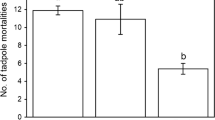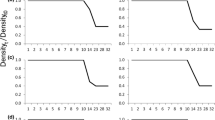Abstract
Invasive species and climate change are important factors in amphibian declines. Climate change mediates impacts on water level fluctuations and amphibian densities. In this study, the interaction effects of invasive species (Gambusia holbrooki), desiccation, and high density were investigated on growth, size, time and percentage of metamorphosis, and survival Bufotes variabilis larvae within 60 d. We designed a 2 × 2 × 3 factorial experiment, crossing two levels of predatory cues (presence/absence), two levels of tadpole density (low/ high) and three levels of water (low/high/ decreasing). Results of the experiment showed mean larval growth rate was highest for both of presence of predator × high water level × high density and presence of predator × decreasing water level × low density treatments (0.30 mm/day). The slowest development time, the lowest percentage of metamorphosis and survival rate were observed at the presence of predator × high water level × high density treatment. Except for the significant impact of the presence of predator and density of tadpoles on survival, independent and interactive effects of three factors showed not significant effects on growth and survival. According to the results of the experiments, although each of the factors of predatory cues, density and water level influence the larval period, size and percentage of metamorphosis separately, however, their interactive effect is not significant. For effective conservation management, this study suggests that more research is needed on different species of amphibians.



Similar content being viewed by others
References
Amiri MJ, Eslamian S (2010) Investigation of climate change in Iran. J Environ Sci Technol 3:208–2016
AmphibiaWeb (2014) Bufotes viridis: Green Toad
Babbitt KJ, Meshaka WE (2000) Benefits of eating conspecifics: effects of background diet on survival and metamorphosis in the Cuban treefrog (Osteopilus septentrionalis). Copeia 2000:469–474
Baber M, Babbitt K (2004) Influence of habitat complexity on predator-prey interactions between the fish (Gambusia holbrooki) and tadpoles of Hyla squirella and Gastrophryne carolinensis. Copeia 4:173–177
Balian EV, Leveque C, Segers H, Martens K (2008) The freshwater animal diversity assessment: an overview of the results. Hydrobiologia 595:627–637
Benard MF (2004) Predator-induced phenotypic plasticity in organisms with complex life histories. Annu Rev Ecol Evol 35:651–673
Bickford D, Howard SD, Ng DJJ, Sheridan JA (2010) Impacts of climate change on the amphibians and reptiles of Southeast Asia. Biodivers Conserv 19:1043–1062
Blaustein AR, Bancroft BA (2007) Amphibian population declines: evolutionary considerations. Bioscience 57(5):437–444
Blaustein AR, Walls SC, Bancroft BA, Lawler JJ, Searle CL, Gervasi SS (2010) Direct and indirect effects of climate change on amphibian populations. Diversity 2(2):281–313
Boorse GC, Denver RI (2004) Endocrine mechanism underlying plasticity in metamorphic timing in spadefoot toads. Integra Comp Biol 43:646–657
Brady LD, Griffiths RA (2000) Developmental responses to pond desiccation in tadpoles of the British anuran amphibians (Bufo bufo, B. calamita and Rana temporaria). J Zool 252(1):61–69.
Brooks R (2009) Potential impacts of global climate change on the hydrology and ecology of ephemeral freshwater systems of the forest of the northeastern United States. Clim Change 95:469–483
Buckley L, Jetz W (2007) Environmental and historical constraints on global patterns of amphibian richness. Proc R Soc B 274:1167–1173
Cabrera-Guzmán E, Díaz-Paniagua C, Gomez-Mestre I (2019) Invasive mosquitofish (Gambusia holbrooki) affect egg-laying and behaviour of Spanish pygmy newts (Triturus pygmaeus). Amphibia-Reptilia 40(1):103–112
Chelgren N, Rosenberg D, Heppell S, Gitelman A (2006) Carryover aquatic effects on survival of metamorphic frogs during pond emigration. Ecol Appl 16:250–261
Çiçek K, Cumhuriyet O (2017) Amphibians and reptiles of the Mediterranean Basin. Mediterranean identities: environment, society, culture. Borna Fuerst-Bjelis, IntechOpen. https://doi.org/10.5772/intechopen.70357
Collen B, Böhm M, Kemp R, Baillie JEM (eds) (2012) Spineless: status and trends of the world’s invertebrates. Zoological Society of London, London
Darwall W, Smith K, Allen D, Holland R, Harrison I, Brooks E (2011) The diversity of life in African freshwaters: underwater, under threat. IUCN, Cambridge
Dastansara N, Vaissi S, Mosavi J, Sharifi M (2017) Impacts of temperature on growth, development and survival of larval Bufo (Pseudepidalea) viridis (Amphibia: Anura): implications of climate change. Zool Ecol 27:228–234
Denver RJ, Mirhadi N, Phillips M (1998) Adaptive plasticity in amphibian metamorphosis: response of Scaphiopus hammondiitadpoles to habitat desiccation. Ecology 79(6):1859–1872
Dudgeon D, Arthington AH, Gessner MO, Kawabata Z-I, Knowler DJ, Lévêque C, Naiman RJ, Prieur-Richard A-H, Soto D, Stiassny ML (2006) Freshwater biodiversity: importance, threats, status and conservation challenges. Biol Rev 81(2):163–182
Enriquez-Urzelai U, San Sebastián O, Garriga N, Llorente G (2013) Food availability determines the response to pond desiccation in anuran tadpoles. Oecologia 173:117–127
Fan X-L, Lin Z-H, Wei J (2014) Effects of hydroperiod duration on developmental plasticity in tiger frog (Hoplobatrachus chinensis) tadpoles. Zool Res 35:124–131
Fraker M (2008) The effect of hunger on the strength and duration of the antipredator response of green frog (Rana clamitans) tadpoles. Behav Ecol Sociobiol 62:1201–1205
Gao X, Jin C, Llusia D, Li Y (2015) Temperature-induced shifts in hibernation behavior in experimental amphibian populations. Sci Rep 5:11580
Girish S, Saidapur S (1999) The effects of kinship and density on growth and metamorphosis of the bronze frog (Ranatemporalis) tadpoles. Acta Ethol 2(1):61–66
Girish S, Saidapur SK (2003) Density-dependent growth and metamorphosis in the larval bronze frog Rana temporalis influenced by genetic relatedness of the cohort. J Biosci 28:489–496
Gosner KL (1960) A simplified table for staging anuran embryos and larvae with notes on identification. Herpetologica 16(3):183–190
Hamer A, Sj L, Mj M (2002) The role of introduced mosquitofish (Gambusia holbrooki) in excluding the native green and golden bell frog (Litoria aurea) from original habitats in south-eastern Australia. Oecologia 132:445–452
Huntington TG (2006) Evidence for intensification of the global water cycle: review and synthesis. J Hydrol 319:83–95
Karraker N, Arrigoni J, Dudgeon D (2010) Effects of increased salinity and an introduced predator on lowland amphibians in Southern China: species identity matters. Biol Conserv 143:1079–1086
Kats L, Ferrer R (2003) Alien predators and amphibian declines: review of two decades of science and the transition to conservation. Divers Distrib 9:99–110
Komak S, Crossland M (2000) An assessment of the introduced mosquitofish (Gambusia affinis and G. holbrooki) as a predator of eggs, hatchlings and tadpoles of native and non-native anurans. Wildl Res 27:185–189
Laurila A, Kujasalo J (1999) Habitat duration, predation risk and phenotypic plasticity in common frog (Rana temporaria) tadpoles. J Anim Ecol 68(6):1123–1132
Laurila A, Kujasalo J, Ranta E (1997) Different antipredator behaviour in two anuran tadpoles: effects of predator diet. Behav Ecol Sociobiol 40(5):329–336. https://doi.org/10.1007/s002650050349
Laurila A, Kujasalo J, Ranta E (1998) Predator-induced changes in life history in two anuran tadpoles: effects of predator diet. Oikos 83:307–317
Lau ETC, Leung KMY, Karraker NE (2019) Native amphibian larvae exhibit higher upper thermal limits but lower performance than their introduced predator Gambusia affinis. J Therm Biol 81:154–161
Lowe S, Browne M, Boudjelas S, De Poorter M (2000) 100 of the World’s worst invasive alien species: a selection from the global invasive species database. Published by The Invasive Species Specialist Group (ISSG), 1–12.
Lowe K, Castley JG, Hero J-M (2015) Resilience to climate change: complex relationships among wetland hydroperiod, larval amphibians and aquatic predators in temporary wetlands. Mar Freshw Res 66(10):886–899
Maciel T, Juncá F (2009) Effects of temperature and volume of water on the growth and development of tadpoles of Pleurodema diplolister and Rhinella granulosa (Amphibia: Anura). Zoologia 26:413–418
Magellan K, García-Berthou E (2016) Experimental evidence for the use of artificial refugia to mitigate the impacts of invasive Gambusia holbrooki on an endangered fish. Biol Invasions 18:1–10
Marquis O, Saglio P, Neveu A (2004) Effects of predators and conspecific chemical cues on the swimming activity of Rana temporaria and Bufo bufo tadpoles. Arch Hydrobiol 160:153–170
McKay F (1971) Behavioral aspects of population dynamics in unisexual-bisexual poeciliopsis (Pisces: Poeciliidae). Ecology 52:778–790
Modarres R, Rodrigues DSV (2007) Rainfall trends in arid and semi-arid regions of Iran. J Arid Environ 70:344–355
Mogali S, Saidapur S, Shanbhag B (2016) Influence of desiccation, predatory cues, and density on metamorphic traits of the bronze frog Hylarana temporalis. Amphib-Reptil 37(2):199–205
Morey S, Reznick D (2000) A comparative analysis of plasticity in larval development in three species of spadefoot toads. Ecology 81:1736–1749
Mosavi J (2015) The effect of degree and hydropriod changes on growth and metamorphism Rana ridibundus. M.Sc Thesis, Razi University of Iran.
Mosavi J, Vaissi S, Dastansara N, Sharifi M (2017) Effects of temperature on growth, development and survival in larvae of Pelophylax ridibundus (Pallas, 1771) (Amphibia: Anura): linking global warming to amphibian development. Acta Zool Bulg 69(4):541–546
Myers N, Mittermeier RA, Mittermeier CG, Da Fonseca GA, Kent J (2000) Biodiversity hotspots for conservation priorities. Nature 403(6772):853–858
Nazaripour H, Mansouri-Daneshvar MR (2014) Spatial contribution of one-day precipitations variability to rainy days and rainfall amounts in Iran. Int J Environ Sci Technol 11:1751–1758
Patimar R, Ghorbani M, Gol-Mohammadi A, Azimi-Glugahi H (2011) Life history pattern of mosquitofish Gambusia holbrooki (Girard, 1859) in the Tajan River (Southern Caspian Sea to Iran). Chin J Oceanol Limn 29:167–173
Rajchard J (2006) Antipredator pheromones in amphibians: a review. Vet Med J 51:409–413
Rose S (1959) Population control in guppies. Am Midl Nat 62:474–481
Rostam Afshar N, Fahmi H (2019) Impact of climate change on water resources in Iran. Int J Energy Water Resour. https://doi.org/10.1007/s42108.019.00013.z
Rohr J, Elskus A, Shepherd B, Crowley P, McCarthy T, Niedzwiecki J, Sager T, Palmer B (2003) Lethal and sublethal effects of atrazine, carbaryl, endosulfan, and octylphenol on the streamside salamander (Ambystoma barbouri). Environ Toxicol Chem 22:2385–2392
Roth S, Jehle R (2016) High genetic diversity of common toad (Bufo bufo) populations under strong natural fragmentation on a Northern archipelago. Ecol Evol 6:1626–1636
Ryan T, Winne CT (2001) Effects of hydroperiod on metamorphosis in Rana sphenocephala. Am Midl Nat 145:46–53
Scott D (1994) The effect of larval density on adult demographic traits in Ambystoma opacum. Ecology 75:1383–1396
Segev O, Mangel M, Blaustein L (2009) Deleterious effects by mosquitofish (Gambusia affinis) on the endangered fire salamander (Salamandra infraimmaculata). Anim Conserv 12(1):29–37
Smith G, Dibble C (2012) Effects of an invasive fish (Gambusia affinis) and anthropogenic nutrient enrichment on American toad (Anaxyrus americanus) tadpoles. J Herpetol 46:198–202
Strayer DL, Dudgeon D (2010) Freshwater biodiversity conservation: recent progress and future challenges. J N Am Benthol Soc 29(1):344–358
Stuart S, Hoffman M, Chanson J, Cox N, Berridge RJ, Ramani P, Young B (2008) Threatened amphibians of the world. Barcelona: Lynx Edicions. IUCN, and Conservation International, Barcelona, Spain, Gland, Switzerland; and Arlington, Virginia, USA.
Tejedo M, Marangoni F, Pertoldi C, Richter-Boix A, Laurila A, Orizaola G, Nicieza AG, Álvarez D, Gomez-Mestre I (2010) Contrasting effects of environmental factors during larval stage on morphological plasticity in post-metamorphic frogs. Clim Res 43(1–2):31–39
Tejedo M, Reques R (1994) Plasticity in metamorphic traits of natterjack tadpoles: the interactive effects of density and pond duration. Oikos 71:295–304
Thibault R (1974) Genetics of cannibalism in viviparous fish and its relationship to population density. Nature 251:138–140
Thiemann G, Wassersug R (2000) Patterns and consequences of behavioral response to predators and parasites in Rana tadpoles. Biol J Linn Soc 71:513–528
Vaissi S, Sharifi M (2016) Variation in food availability mediate the impact of density on cannibalism, growth, and survival in larval yellow spotted mountain newts (Neurergus microspilotus): Implications for captive breeding programs. Zoo Biol 35(6):513–521
Wilbur H (1987) Regulation of structure in complex systems: experimental temporary pond communities. Ecology 68:1437–1452
Wildy EL, Chivers DP, Kiesecker JM, Blaustein AR (2001) The effects of food level and conspecific density on biting and cannibalism in larval long-toed salamanders, Ambystoma macrodactylum. Oecologia 128:202–209
Acknowledgements
We thank Razi University for the support of this study as an MSc research project. The permit for sampling and working live animals were issued by approval of the Razi University Animal Ethics Committee with the code number 396-1-023.
Author information
Authors and Affiliations
Corresponding author
Rights and permissions
About this article
Cite this article
Najafi, M., Esmaeili-Rineh, S. & Vaissi, S. Interactions Between Ecological Factors in the Development and Survival of Bufotes variabilis: Resilience to Change. Iran J Sci Technol Trans Sci 45, 1941–1949 (2021). https://doi.org/10.1007/s40995-021-01208-y
Received:
Accepted:
Published:
Issue Date:
DOI: https://doi.org/10.1007/s40995-021-01208-y




